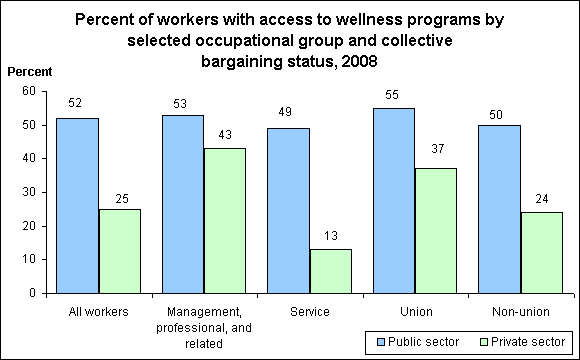April 23, 2009
(The Editor’s Desk is updated each business day.)
Wellness programs
Wellness programs are considered to be an important component of employer benefits packages because they offer workers and their families choices for pursuing healthier lifestyles with less illness, ultimately leading to less costly benefits packages. Examples of benefits that may be included in wellness programs are smoking cessation clinics, exercise/physical fitness programs, weight control programs, and nutrition education.

[Chart data—TXT]
Other benefits that may be offered are hypertension tests, periodic physical examinations, stress management courses, and back care courses. Wellness programs, as defined by the National Compensation Survey, offer employees two or more of those eight benefits.
In 2008, public sector workers in management, professional, and related occupations and in service occupations had access to wellness programs at about the same rate. Private sector workers in management, professional, and related occupations, however, had a notably higher rate of access than did private sector workers in service occupations.
Public sector union and nonunion workers had access to wellness programs at about the same rate in 2008, but private sector union workers had higher rates of access than did private sector nonunion workers.
These data are from the BLS National Compensation Survey program. To learn more, see Access to Wellness and Employee Assistance Programs in the United States, by Eli R. Stoltzfus, Compensation and Working Conditions Online, April 2009.
Of interest
Spotlight on Statistics: National Hispanic Heritage Month
In this Spotlight, we take a look at the Hispanic labor force—including labor force participation, employment and unemployment, educational attainment, geographic location, country of birth, earnings, consumer expenditures, time use, workplace injuries, and employment projections.
.
Read more »
